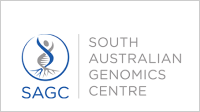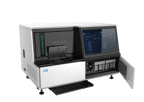
Genomics Services
Supporting a wide range of state-of-the-art genomics technologies
| Technique | What is it? | What is it used for? |
|---|---|---|
Whole-Genome Sequencing (WGS)Download Guide |
Whole-Genome Sequencing (WGS) is a comprehensive method for analysing entire genomes. WGS entails sequencing all of an organism’s chromosomal DNA as well as DNA contained in the mitochondria, and for plants, in the chloroplast. | WGS is commonly used for interrogating inherited disorders, characterizing the mutations that drive disease progression and tracking disease outbreaks. WGS is a method that is applicable for any species such as human, agriculturally important livestock, plants, insects and microbes. |
Whole-Exome Sequencing (WES)Download Guide |
WES is a comprehensive method for analysing all of the protein-coding regions of genes in the genome. Unlike WGS, WES focuses on the 1% of the genome where severe disease-causing variants are more likely to occur, thus reducing sequencing costs. | WES is most typically used for diagnosing the genetic cause of a disease in clinical and agricultural settings. WES is especially effective for the study of Mendelian diseases where genetic variants are very rare and therefore require in-depth analysis. |
Enzymatic Methyl-SeqDownload Guide |
Whole Genome Bisulfite (WGBS) enables the genome-wide identification and quantification of DNA methylation patterns. DNA methylation involves the addition of a methyl group to a cytosine base and is one of the main types of epigenetic modifications in eukaryotes. | DNA Methylation plays a significant role in many biological processes, including the regulation of gene expression, transcription factor binding and suppression of transposable elements. |
Single Cell RNA sequencing (scRNA-seq)Download Guide |
scRNA-seq examines the gene expression level of individual cells in a given population by simultaneously measuring the mRNA concentration of hundreds to thousands of genes. By analysing the transcriptome of a single cell at a time, the heterogeneity of the samples is captured. | scRNA-seq applications include tracking the trajectory of cells in disease states as well as a more in-depth look at gene expression variations. |
Spatial Transcriptomics (ST) ServiceDownload Guide |
ST allows the measurement of gene expression within the context of native tissue architecture and at a cellular level combining the benefits of histology with the discovery power of mRNA sequencing. Bringing these complementary methods together offers a previously inaccessible view of tissue biology. | Spatial Transcriptomics applications include mapping the whole transcriptome with morphological context in fresh-frozen or FFPE tissues to discover novel insights into normal development, disease pathology and clinical translation research. |
Total RNA and mRNADownload Guide |
RNA Sequencing (RNA-Seq) is a powerful and comprehensive method for analysing the transcriptome. RNA-Seq can be performed in two ways. TotalRNA-Seq is the most comprehensive approach and involves the sequencing of multiple RNA molecules, both coding and non-coding, while mRNA-Seq focuses on the coding region only. | RNA-Seq applications include profiling changes in gene expression and alternative splicing events (mRNA & TotalRNA) as well as the discovery of novel non-coding RNA (TotalRNA). Both techniques are commonly used for interrogating basic cellular structure and function as well as the analysis of various disease states in clinical settings. |
Chromatin Immunoprecipitation Sequencing (ChIP-Seq)Download Guide |
ChIP-Seq is a powerful method for identifying genome-wide DNA binding sites for transcription factors and other proteins. Unlike probe-based methods derived from known sequences, ChIP-Seq provides genome-wide profiling generating millions of counts across samples. | ChIP-Seq applications include the analysis of population-level interactions between protein and DNA, the discovery of new regulatory elements and enables a greater understanding of disease mechanisms and epigenetic changes for clinical applications. |
Small RNA Sequencing (Small RNA-seq)Download Guide |
Small RNAs are short (approximately 20 – 200 nucleotides), non-coding RNA molecules that play critical roles in post-transcriptional regulation of gene expression and gene silencing. Small RNA-seq involves the isolation and sequencing of small RNA species, such as microRNAs (miRNAs). | Commonly used for miRNA profiling to determine epigenetic changes in gene expression within the cell. |
Assay of Transposase Accessible Chromatin Sequencing (ATAC-Seq)Download Guide |
ATAC-Seq is a popular method for interrogating chromatin accessibility across the genome. By sequencing regions of open chromatin, ATAC-Seq can uncover how chromatic packaging and other factors effect gene expression. | ATAC-Seq applications include the analysis of nucleosome mapping, novel enhancer identification, comparative epigenomics, and biomarker discovery. |
Metagenomics |
Metagenomic sequencing, also known as whole shotgun sequencing, involves the collection of genetic material (genomes) from a mixed community of organisms and is a commonly used method in microbial community studies. Unlike the 16S approach, which is limited to taxonomic classifications, metagenomics uses fragments of DNA from the whole genome/microbial community allowing both phylogenetic and gene classification information to be captured. This non-targeted approach also means that DNA from the whole community, including bacteria, viruses, fungi and eukaryotes can be sequenced. | Metagenomic sequencing is commonly used for interrogating the taxonomic and functional information in complex microbial communities from clinical, agricultural and environmental samples. |
Microbial Profiling (Microbiome)Download Guide |
Microbiome studies are commonly performed by analysing the bacterial 16S ribosomal RNA gene hypervariable regions and/or the fungal Internal Transcribed Spacer (ITS) of nuclear DNA. The 16S and ITS regions are comprised of hypervariable regions flanked by highly conserved regions, and thus Universal PCR primers can be designed to target and amplify these genes in a wide range of sample types. | Targeted gene sequencing of the 16S and ITS regions is commonly used for phylogenetic classifications and estimating the relative abundance of particular groups in complex biological mixtures including from clinical and environmental samples. |
AmpliconDownload Guide |
Amplicon sequencing relies on ultra-deep sequencing of PCR products (amplicons) to analyse genetic variation in specific genomic regions. Its relative low cost, and high sensitivity way of targeting specific genomic regions allowing efficient variant identification and characterisation. |
Amplicon sequencing is widely used in various applications, including microbial ecology, genetic diagnosis of diseases, studying genetic variation within populations, and environmental DNA analysis. Amplicon sequencing has naturally higher on-target rates than other targeted sequencing methods due to the precision of primer design. This method is appropriate for genotyping by sequencing, identification of germline single nucleotide polymorphisms (SNPs), insertions/deletions (indels), and known fusions. |
|
Sequencing Platform |
FLOW CELL |
Read Lengths |
Data Output (Gb)* |
Reads Per Flow Cell (million bases)* |
|
DNBSEQ-T7 |
FCL |
PE75 PE100 PE150 |
750-900 1000-1200 1500-1700 |
5000-5800 |
|
DNBSEQ-G400
|
FCL |
SE100 PE100 PE150
|
150-180 300-360 450-540 |
1500-1800 |
|
NextSeq |
High Output |
SE75 PE75 PE150 |
25-30 50-60 100-120 |
400 |
|
Mid Output |
PE75 PE150 |
16.25-19.5 32.5-39 |
130 |
|
|
MiSeq |
Nano |
PE150 PE250 |
0.3 0.5 |
1 |
|
Micro |
PE150 |
1.2 |
4 |
|
|
v2 |
PE25 PE150 PE250 |
0.75-0.85 4.5-5.1 7.5-8.5 |
12-15 |
|
|
v3 |
PE75 PE300 |
3.3-3.8 13.2-15 |
22-25 |
|
|
MiSeq i100 Plus |
5M |
PE150 PE300 |
1.5 3 |
5 |
|
25M |
SE100 PE150 PE300 PE500 |
2.5 7.5 15 25 |
25 |
|
|
50M |
SE100 PE150 PE300 |
5 15 30 |
50 |
|
|
100M |
SE100 PE150 |
10 30 |
100 |
Interested in long-read sequencing?
We offer Oxford Nanopore and PacBio long-read sequencing through our partners.



